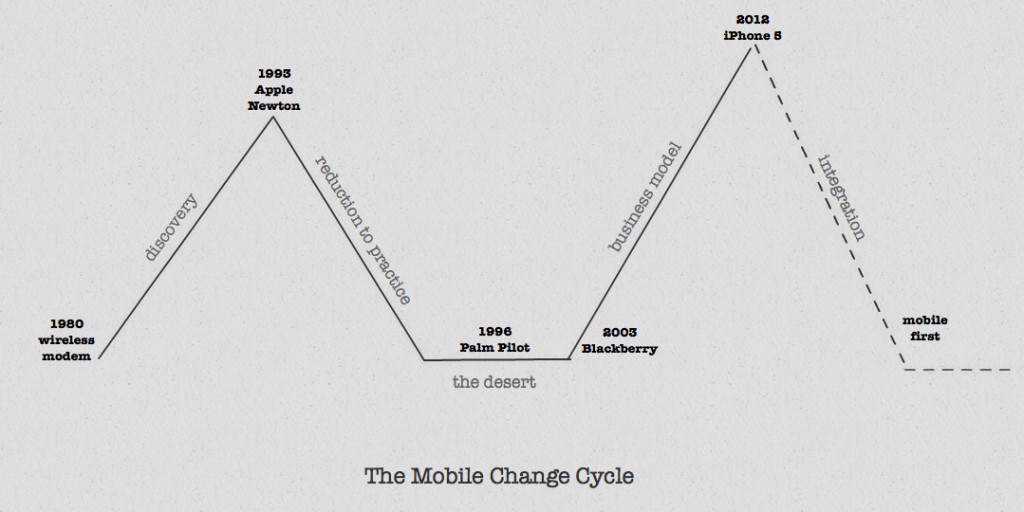This is the third in a series of posts about using change waves to accelerate growth (here’s the first, and the second).
Mapping in Real-time
I’ve been using historical examples to make the case that change waves start with discoveries decades before they break as large-scale business disruptors.
In most cases, it is possible to map this reasonably predictable cycle of discovery and integration. This is great news, because it means as students of change, we can be prepared and ready to capitalize on its potential.
In the last post, we covered how to draw the invention and deployment curves for an innovation. For illustrative purposes, we largely used changes that have already played out, so that you could get used to the methodology and develop some analytical muscle.
For this post, I am going to tackle a trend that is actively working itself out in our space real time: mobile technology. This way you can begin to develop some comfort in how to attack the maps you want to draw and touch on how to develop strategy and approaches.
Complementary Change Waves
Before we tackle mobile, let me introduce one more concept: complementary change waves. This is when several change waves occur at once, interfering with and reinforcing one another.
Complementary change waves are like the wakes of boats — every so often there will be a spot where the wakes of many boats multiply one another, creating a wave more than double the size of the smaller waves. If you’re towing some inner-tube riders with your own boat, pull them over these and they’ll catch some serious air.
The same thing happens with innovations. When many breakthroughs occur at once, their change waves intersect and overlap. This can do two things – either the waves cancel each other out, or they add to one another.
The SUV is a good example of complementary additive change waves. The SUV became emblematic of a generation, which drove massive waves of sales. The complementary change waves were demographic (baby boomer moms), economic (gas was cheap) and social (keeping up with the Joneses). Result? The boom of sales, followed by a bust when gas prices changed.
The Tsunami of Mobile
It’s very likely that the Internet connection in your pocket is stronger and faster than the desktop connection this was written on.
Here is good chart on the growth of mobile data consumption:
So what does this mean for the future of our industry? Is it a true, deep change wave? Let’s dissect this one together using the analysis tools we’ve learned.
Here again is our two-part change cycle:
Checking Google for wireless data network history we find some rich information:
Date Event
Early 1980s Wireless modem (Data Radio)
1983 ARDIS (Motorola/IBM)
1990 IEEE 802.11 for Wireless LAN standards
1992 ETSI and HIPERLAN in Europe
1993 Release of 2.4, 5.2, and 17.1–17.3 GHz bands in EU
1993 CDPD (IBM and 9 operating companies)
1994 PCS licensed and unlicensed bands for PCS
1997 U-NII bands released, IEEE 802.11 completed, GPRS started
1998 IEEE 802.11b and Bluetooth announcement
We find the origins of this change wave in 1980, or about 30 years ago, which matches up with our changewave methodology. Because we know that it takes time to mature one of these changes, we are skeptical of “instant” revolutions with no prior art. Does anyone recall the date for the Newton, Apple’s early foray into the world of PDAs? For those of you who didn’t live that part of history, the Newton was universally panned as being too slow, hard to carry and with handwriting recognition that was used as a cartoon parody. I’ll use that as the peak for the downslide. That was in 1993.
In 1996 the Palm Pilot showed up, primarily as a repository of our desktop contact base. Lets use this as the first business model on the way back up – very high latency mobile, actually via a cable and a click on the desktop. This was a huge step forward – we could finally stop carrying our printed phone lists while traveling. Interestingly, this was also the time of an explosion of contact info, since cell phones were rapidly gaining ground and now everyone had an email address. This data overload was one of the underlying drivers (and a complementary wave) for automating our address books.
Let’s use the Blackberry as the front of the upside curve. It was the first model to solve two issues – near real-time sync and security that was good enough for enterprise IT. The first model was released in 1999, with the model we all remember hitting in 2003, let’s use that for the front of the upslope. Note that it is 10 years from the peak of the discovery cycle to the beginning of the upslope on deployment.
The big question: have we peaked yet?
This is the key question and one many product planners are considering carefully right now.
It’s highly likely we are nearing the top, but will have multiple plateaus. Mobile devices still have a long path of improved interface work to go before they can become the seamless companion of science fiction. Recall that a peak here doesn’t mean the market has stopped growing, but that the market is turning into integrating and turning into a “red ocean”, where P&G like brand discipline trumps technical and business model innovation,
The real reason this one’s a tsunami, is because we’re feeling the effects of three big waves simultaneously. Look at this report about demographics developed from data from Pew research — the members of the digital generation are about to become the core breadwinners in our society. They are used to having any data they want at their fingertips:
User interfaces have never been better. Moore’s law has made the carry-around capability and price of these devices amazingly accessible. The confluence of computer and cellular networks is keeping them fed, and long international supply chains are keeping them cheap.
User Interface Design + Moore’s Law + Faster Wireless Networks + Demographic Shift = Monster Changewave
What conclusions can we draw or trends can we spot in this? Here a few:
- The action is at the edges. The middle is disappearing in how we build human systems and networks. In the Army, the ubiquity of mobile is changing the way the soldiers go to battle. Rather than having inflexible one-way communication, the new norm is instant feedback from the front lines. This means a soldier often has the best intelligence of the situation – and that information needs to go to the data center real time. Mobile means that value is moving to the edge of our networks, and a centralized system is no longer effective. Location is huge and deserves its own homework to map the changewave.
- Commerce is becoming intelligent. For the first time ever we have a connected device that is present and informed at the point of the transaction. This is unprecedented in the history of commerce, and the full effect will not be felt for years. The fun will really being when location, social networking and predictive analytics begin to serve up offerings for the next most likely scenario.
- The office is disappearing. The office is already unnecessary for a huge number of jobs that used to require the regular commute, but imagine when SalesForce.com automates the entire pathway and interaction pattern for an account manager without him having to type a single word? What is the back office serves up the most likely contacts for the day based on a deep scan of news and business trends — big massive computers combing through big data every night?
These and other scenarios will become realized over the next decade, and make it a great time to be alive.
Will you be the bug, or the windshield?
One of my mentors was fond of saying: you are either the bug or the windshield, you decide.
Now that you have the tools to place your business on these change cycles, it’s time to start using them to prepare for what’s coming.
With careful analysis, using the tools I have described, you can be riding the change wave instead of having it crash over you.
So how do you get out in front of the cycle? In the next post we’ll talk about the most effective structures for addressing these changes, — how to form them, guide them and get the most from them. In the meantime, please drop me an email or tweet me with your thoughts.



